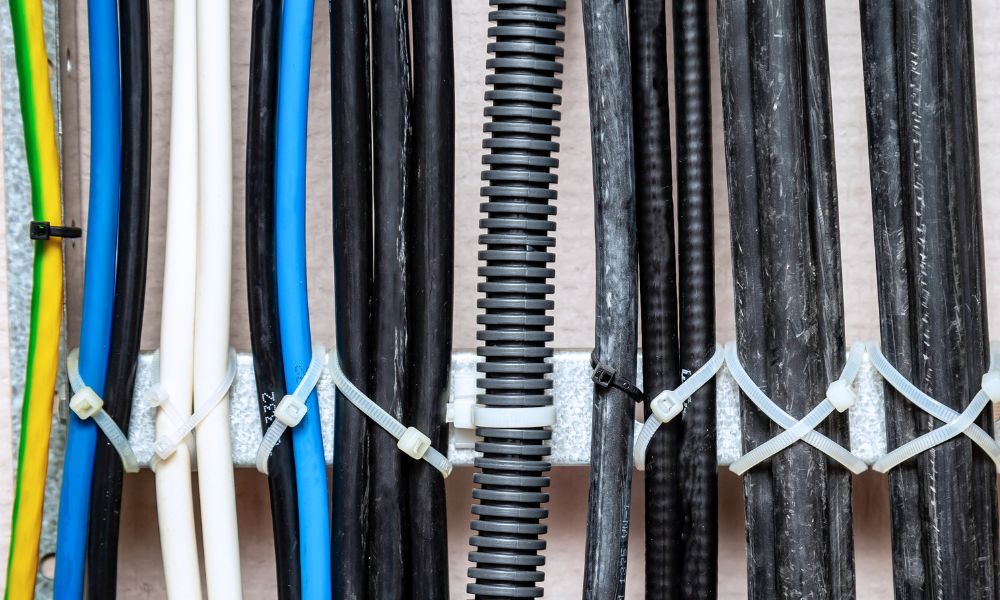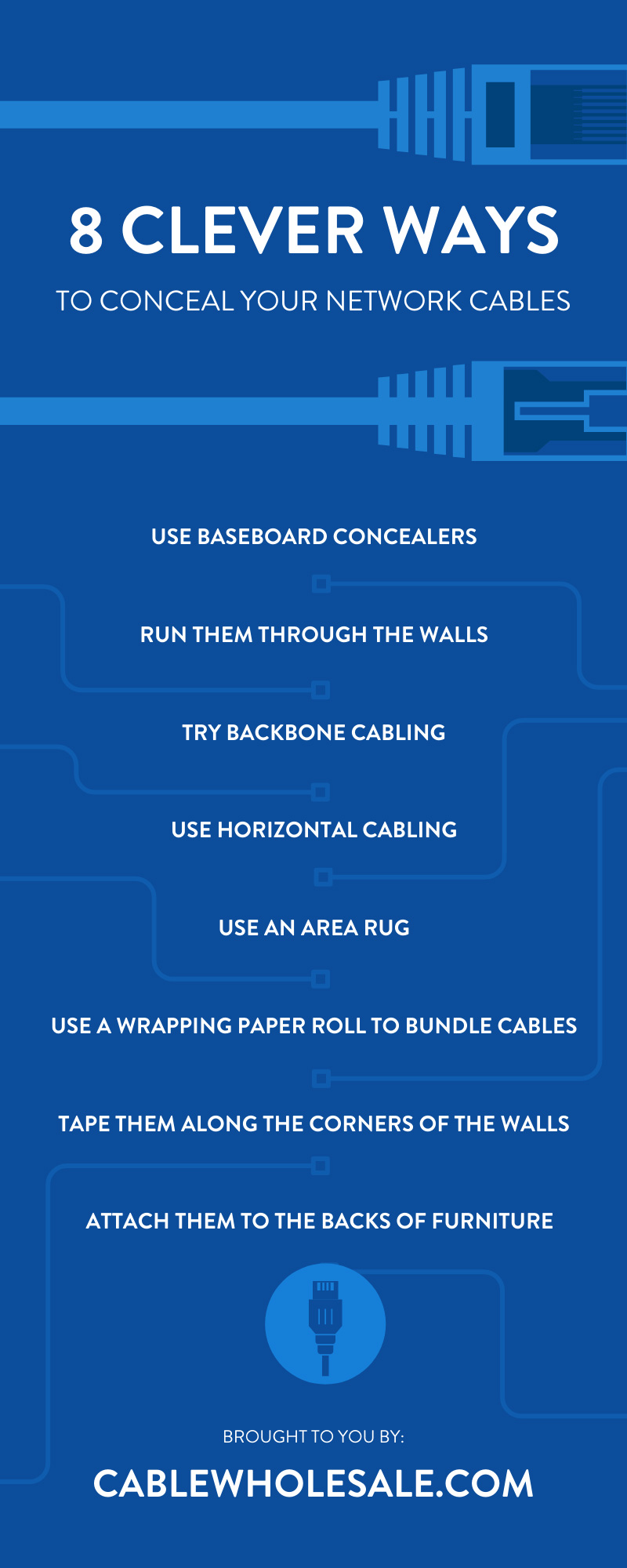
The cables used in our networks may become damaged when they are out in the open. Concealing your network cables is the best way to keep them safe, and there are some clever methods to tuck them away. Read on for creative ideas to conceal and keep your network cables safe.
Use Baseboard Concealers
The baseboards in a room often go unnoticed by most people, making them an ideal place to hide cables. Use baseboard organizers along your walls to conceal cables as you run them along the baseboards. Slide the cables through the concealers before attaching them to the baseboards for easier installation along the room’s corners.
Check the length of the cable inside the baseboard concealers to ensure they reach both connection points; you want to avoid installing them and falling short in the length you need for a connection. These concealers will also protect the cables thanks to the durable plastic they’re made from. Baseboard concealers come in different colors, such as brown and white, to match most neutral tones of baseboards, adding to the concealing effect and making them less noticeable.
Run Them Through the Walls
The walls of a room are great places to conceal cables and run them to different locations. Find the best spaces to make holes in the wall with a stud finder and mark them with a pencil. Cut holes in the wall large enough to fit the cable’s diameter; ensure you have a tarp or other disposable material to catch any dust from the drilling or sawing.
Use fish tape to run the cable from the opening to the exit by attaching the top of the cable to the hook of the fish tape cord. The last step may feel challenging, especially if the hole you made is too small, but with patience, you’ll eventually get the cable out of the other side to connect to another device.
Keep Track of Where They Are
If it’s possible to know where the cable is in the wall, keeping track of its position in the future is helpful. If you ever nail anything to the wall, you’ll want to avoid driving a nail through the cable and causing damage that could lead to malfunction or a disconnect.
Or, if you need to run more cables through the wall, it’s helpful to know where you ran the last cable along the wall. Creating a diagram of the wall cabling will give you a picture of the structure and prevent you from needing to mark up the wall to know where the cable is. Understand your cabling layout for the best cable management and keep track of the cable concealment so you don’t lose track of it.
Try Backbone Cabling
Backbone cabling is a clever way to conceal network cables by running them through the building infrastructure. This type of cabling is great for cables that need to connect to multiple places on separate floors of a building and run up or down. For example, suppose a server room is on the fifth floor of a building, and a device needs to connect to a server on the second floor.
In that case, the cables need to remain concealed to mitigate the possibility of something or someone disconnection or harming it. The cables will lead into a port in the wall and travel upward through the building until it exits on the desired floor.
Run multiple cables through the building with this method and keep the wired connection unseen and secured. You’ll need to ensure that both connection points are near walls to reduce the stretching cables needed and prevent the cables from becoming too exposed.
Use Horizontal Cabling
Like backbone cabling, horizontal cabling moves through the building’s infrastructure horizontally instead of vertically. Horizontal cabling will keep cables concealed by running them underneath the floor from an opening from one device to another.
Insulation is an integral part of this cabling to avoid objects and people putting pressure on the cables. The cables will typically get installed during the building construction and remain under the floors of one of the buildings’ levels.
Attach Them to the Backs of Furniture
One of the best places to conceal anything is behind a room’s furniture. Couches, chairs, desks, and anything else large enough that a cable will tape to the back of it is ideal. Use duct or electrical tape to attach the cables to the backs of furniture and keep them concealed.
This concealment is a simple method that will lead the cable around a room and maneuver it past large obstacles that would otherwise get in the way. The cables will remain tucked away, and people won’t notice them as they sit. When you tape them to desks, you’ll have an easier time connecting cables and setting up your devices.
Use a Wrapping Paper Roll To Bundle Cables
A simple way to manage cables and simultaneously keep them concealed is to lead them through an empty wrapping paper roll. The cardboard cylinder that holds wrapping paper will normally be four feet or longer and feature durable cardboard.
Place these rolls on the sides of a room and lead your cables through them for an extended cover. Decorate the roll for an aesthetic or blending purpose to reduce noticeability and improve concealment.
Mind the Interference
You may need to worry about interference if you run multiple cables through the same roll. Ethernet or coaxial cables will emit electromagnetic waves that cause interference to nearby cables.
As these cables remain bundled, the chances of the data they transfer becoming scrambled increases. Use foil shielding cables to mitigate interference and improve the performance of each line. Switch to fiberoptic cables to reduce the chance of interference altogether and enhance the performance of your network.
Tape Them Along the Corners of the Walls
If you have a device such as a TV or monitor hanging on a wall in a corner will require cables to move upward and dangle. Make the connection by running the cable along the corners of the wall and up. Using tape of the same color as the wall is effective in blending the connection and keeping the cable stationary while it’s connected.
Thicker cables, such as SCSI adapter cables, will be heavier than others and need support to stay upright when connected to a port above it. The tape will hold the cable still and create a more reliable connection.
Use an Area Rug
Many people use rugs to cover blemishes on the floor. Rugs give the room a nice visual element while cleverly concealing network cables underneath it. You will need a cable protector if the rug is in a high-traffic area to protect it from getting trampled, but a large enough rug will keep both the protector and cable hidden and organized in the space.
Some items need to remain hidden for their protection. Concealing cables is an integral part of cable management, and with these clever methods, your cables will stay out of sight and out of mind.




